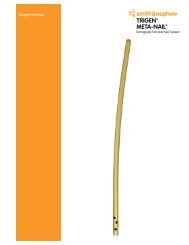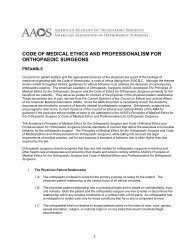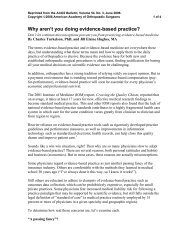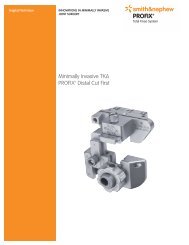Read the article from AAOS Now - American Academy of ...
Read the article from AAOS Now - American Academy of ...
Read the article from AAOS Now - American Academy of ...
Create successful ePaper yourself
Turn your PDF publications into a flip-book with our unique Google optimized e-Paper software.
Disclosure is “good” for <strong>the</strong> soul<br />
For a number <strong>of</strong> years I have been a reviewer for The Journal <strong>of</strong> Bone and Joint Surgery and <strong>the</strong><br />
Journal <strong>of</strong> Pediatric Orthopaedics (I <strong>of</strong>ten wondered why), and now I have a chance to use <strong>the</strong>se<br />
skills in reviewing an <strong>article</strong> <strong>from</strong> The New England Journal <strong>of</strong> Medicine (NEJM).<br />
I realize that <strong>the</strong> NEJM is a highly revered journal, beyond reproach, and<br />
is thoroughly peer-reviewed. It is frequently cutting edge and, to my<br />
mind, sometimes a bit far to “<strong>the</strong> left,” but always “Bostonian.” The<br />
original <strong>article</strong>s are always highly scrutinized by an excellent editorial<br />
staff and reviewers. So it is with great thought that I make any critical<br />
comments about <strong>the</strong> <strong>article</strong> “Conflict <strong>of</strong> Interest Disclosures Reported by<br />
Physicians” (NEJM, October 8, 2009). (See “Are orthopaedists<br />
trustworthy?”)<br />
First <strong>of</strong> all, <strong>the</strong> objective part <strong>of</strong> <strong>the</strong> <strong>article</strong> cannot be challenged: only 71.2 percent <strong>of</strong> payments<br />
made to orthopaedists <strong>from</strong> five orthopaedic device companies were self-disclosed prior to <strong>the</strong><br />
<strong>AAOS</strong> 2008 Annual Meeting. I think <strong>the</strong> first point that ought to be made is that <strong>the</strong> online<br />
reporting by <strong>the</strong> companies was done under very specific requirements imposed by <strong>the</strong><br />
Department <strong>of</strong> Justice (DOJ) in 2007. In contrast, <strong>the</strong> disclosure statements made by <strong>the</strong><br />
orthopaedists, although required by <strong>the</strong> <strong>AAOS</strong>, were self-reported.<br />
I understand <strong>the</strong> authors’ method <strong>of</strong> determining relatedness: directly related payments (79.3<br />
percent <strong>of</strong> which were disclosed), indirectly related payments (50 percent <strong>of</strong> which were<br />
disclosed), and unrelated payments (49.2 percent <strong>of</strong> which were disclosed). I also agree with<br />
<strong>the</strong> statements that those receiving more than $10,000—especially those receiving more than<br />
$100,000—were most likely to disclose and that payment to an individual physician was more<br />
likely to be reported than payments to a company or organization or with an “in-kind”<br />
component. All <strong>of</strong> this is hard to argue with, and it is what it is. We should have done better.<br />
The <strong>AAOS</strong> has been constantly improving its disclosure policy over <strong>the</strong> years. It is progress, not<br />
perfection. I know <strong>of</strong> three problems—and I think I have a solution to each. One is compliance<br />
by <strong>the</strong> fellows (too much trouble). I think <strong>the</strong> authors are correct in suspecting that legislation<br />
requiring all drug and device manufacturers to publicly disclose payments to physicians will
ultimately be passed. I am sure physicians would prefer self-disclosure to having disclosures<br />
made by a third party. This is what <strong>the</strong> <strong>AAOS</strong> is trying to achieve.<br />
Second, although I believe most orthopaedists want to do <strong>the</strong> right thing, some are uncertain<br />
about what to disclose. At <strong>the</strong> time, each author was not required individually to report. The<br />
primary author on a paper, poster, or exhibit was asked to contact <strong>the</strong> o<strong>the</strong>r authors and get<br />
<strong>the</strong>ir disclosure information. This may have created some confusion.<br />
In addition, in <strong>the</strong> follow-up survey conducted by <strong>the</strong> authors, 38.9 percent <strong>of</strong> responders said<br />
that <strong>the</strong>ir reason for not disclosing was that <strong>the</strong> payment was unrelated to <strong>the</strong> topic presented.<br />
The solution, I believe, is one <strong>the</strong> <strong>AAOS</strong> has already developed: to require each author to<br />
individually disclose all potential conflicts, regardless <strong>of</strong> whe<strong>the</strong>r or not <strong>the</strong> relationship is<br />
“relevant” to <strong>the</strong> presentation.<br />
This eliminates both sources <strong>of</strong> confusion. First, one doesn’t have to decide what to<br />
disclose—one simply discloses everything. Second, one doesn’t have to decide how relevant <strong>the</strong><br />
relationship is—one simply discloses everything. How much simpler—and more honest—can it<br />
be?<br />
The third problem may have been that some researchers and educators simply did not disclose<br />
prior to <strong>the</strong> meeting itself. They may have included <strong>the</strong>ir disclosure on slides at <strong>the</strong> beginning <strong>of</strong><br />
<strong>the</strong>ir presentation, as required, or admitted to conflicts under questioning by <strong>the</strong> session<br />
moderators, but because <strong>the</strong> disclosure was not included in <strong>the</strong> final program, <strong>the</strong> researchers<br />
could only assume that it was not made at all.<br />
The <strong>AAOS</strong> has a mandatory disclosure policy; if you don’t submit <strong>the</strong> disclosure forms, your<br />
poster or paper will be removed, and, if you are a faculty member, you will be replaced. (See<br />
“Annual Meeting participant guidelines”)<br />
I must admit that I am a bit underwhelmed and disappointed by <strong>the</strong> variables that were not<br />
controlled in <strong>the</strong> authors’ follow-up survey. When one considers <strong>the</strong> total number <strong>of</strong><br />
orthopaedists who participated as presenters, faculty, board, or committee members, <strong>the</strong> 91<br />
who did not disclose is a small number, and <strong>the</strong> response rate <strong>of</strong> 39.6 percent (36 physicians)<br />
may not be valid to come up with any conclusions <strong>of</strong> why orthopaedists did not disclose. Much<br />
was made <strong>of</strong> statistics in <strong>the</strong> findings, but little was said about <strong>the</strong> statistical validity <strong>of</strong> <strong>the</strong><br />
survey, which was mailed more than a year after <strong>the</strong> date to disclose had passed.<br />
I was also bo<strong>the</strong>red by <strong>the</strong> way <strong>the</strong> survey questions were written. No one is going to answer<br />
“Intentionally omitted” when questioned about reasons for not disclosing. As you might guess,<br />
<strong>the</strong> number giving this answer in <strong>the</strong> survey was zero. This, coupled with <strong>the</strong> fact that those<br />
most likely to disclose payments were those who received large sums, would seem to indicate<br />
that <strong>the</strong> omission was not done to conceal payments but occurred as a result <strong>of</strong><br />
misunderstanding. We should have known better.<br />
Unfortunately, publication <strong>of</strong> this “exposé” may help fur<strong>the</strong>r legislation, resulting in greater<br />
government oversight and involvement in medicine. Additionally, I use <strong>the</strong> term “exposé”<br />
because I believe <strong>the</strong> <strong>article</strong> went “over <strong>the</strong> top” in its reporting <strong>of</strong> <strong>the</strong> amount <strong>of</strong> money not<br />
disclosed. Was this really necessary, especially since <strong>the</strong> amount <strong>of</strong> money received is not<br />
disclosed at <strong>the</strong> Annual Meeting?
The image <strong>of</strong> <strong>the</strong> orthopaedic community and <strong>the</strong> <strong>AAOS</strong> have recently suffered because <strong>of</strong> <strong>the</strong><br />
DOJ investigation. I think <strong>the</strong> <strong>article</strong> gave <strong>the</strong> orthopaedic community ano<strong>the</strong>r “black eye” in a<br />
healthcare environment that is filled with monetary worry and concern. It could have been<br />
done better.<br />
Ah, but it’s a new day. The <strong>AAOS</strong> continues to update and refine its disclosure policy, to close<br />
loopholes, and put some real bite in <strong>the</strong>ir punitive actions concerning disclosure at <strong>the</strong> Annual<br />
Meeting. We can’t afford to do o<strong>the</strong>rwise, and I applaud our Education Council and Annual<br />
Meeting committees for <strong>the</strong>ir ongoing efforts to make educators as transparent as possible<br />
concerning disclosure, to make guidelines for disclosure clear and concise, and to eliminate<br />
commercialism and bias. It will get better.<br />
I will conclude with my “Disclosure is good for <strong>the</strong> soul” prayer: Lord, we should have known<br />
better; we could have done better. But Lord, we are better than we used to be, and we will get<br />
even better—and that’s good for <strong>the</strong> soul.<br />
<strong>AAOS</strong> <strong>Now</strong><br />
November 2009 Issue<br />
http://www.aaos.org/news/aaosnow/nov09/youraaos2.asp<br />
-PRIVACY POLICY- Disclaimers & Agreement Advertising & Sponsorship Contact <strong>AAOS</strong> Technical Requirements Careers<br />
6300 North River Road Rosemont, Illinois 60018-4262 Phone 847.823.7186 Fax 847.823.8125<br />
© 1995-2010 by <strong>the</strong> <strong>American</strong> <strong>Academy</strong> <strong>of</strong> Orthopaedic Surgeons. "All Rights Reserved." This website and its contents may not be<br />
reproduced in whole or in part without written permission. "<strong>American</strong> <strong>Academy</strong> <strong>of</strong> Orthopaedic Surgeons" and its associated seal and<br />
"<strong>American</strong> Association <strong>of</strong> Orthopaedic Surgeons" and its logo are all registered U.S. trademarks and may not be used without written<br />
permission.







